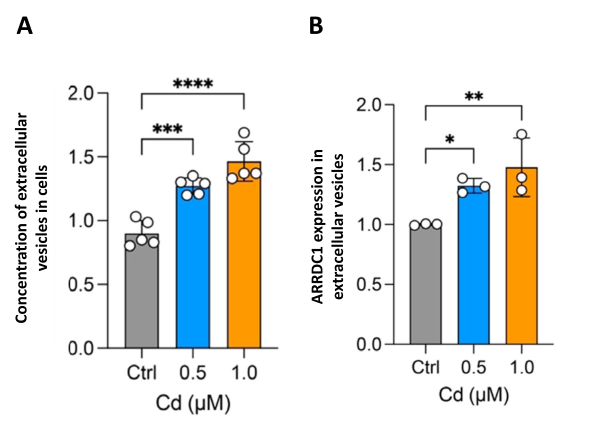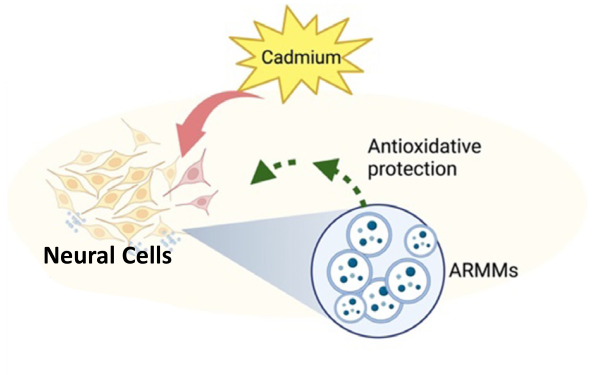Superfund Research Program
Mechanism of Cadmium-induced Neurotoxicity, Potential Treatment Revealed
View Research Brief as PDF(2.1MB)
Release Date: 10/04/2023
![]() subscribe/listen via iTunes, download(5.1MB), Transcript(88KB)
subscribe/listen via iTunes, download(5.1MB), Transcript(88KB)
A particular class of extracellular vesicles protects against neurotoxicity caused by cadmium exposure, according to an NIEHS Superfund Research Program (SRP)-funded study. Extracellular vesicles are small packages of fats, nucleic acids, or proteins that allow cells to communicate with each other and support numerous cellular functions.
Cadmium, a ubiquitous heavy metal pollutant resulting from mining, smelting, and other industrial processes, can accumulate in soil and water. Cadmium exposure has been linked to neurotoxicity, but the underlying mechanisms involved are not well known.
Led by postdoctoral fellow Zunwei Chen, Ph.D., and Center Director Quan Lu, Ph.D., of the Harvard SRP Center, researchers set out to explore if a unique class of extracellular vesicles, called arrestin domain-containing protein 1 (ARRDC1)-mediated microvesicles (ARMMs), may hold part of the answer. Unlike other extracellular vesicles, ARMMs bud directly from the cell’s plasma membrane when the protein ARRDC1 is present.
Neural Cells Respond to Cadmium
The team carried out a series of experiments exposing a human neural cell line to cadmium. Then they looked at toxicity to the cells, the amount of extracellular vesicles produced and their contents, and markers of oxidative stress.
Extracellular vesicle production increased with cadmium dose in neural cells. Within vesicles, 392 proteins were unique to the cadmium-exposed cells.

In particular, ARRDC1 was enriched within extracellular vesicles exposed to cadmium, leading the researchers to suggest that cadmium exposure likely increased the production of ARMMs in the neural cells.
ARMMs Help Block Neurotoxicity
To confirm the role of ARMMs, the researchers then looked at neural cells without the ability to produce ARRDC1, and therefore ARMMs, using similar methods.
In cells modified to lack ARRDC1, overall production of extracellular vesicles decreased by 30-40%, which the authors attributed to the lack of ARMMs.
Cells without ARRDC1 were more susceptible to cytotoxicity resulting from cadmium exposure. These cells had higher markers of oxidative stress and higher expression of oxidative stress genes compared to cells with ARRDC1, which had higher expression of antioxidant proteins.

When the scientists added isolated ARMMs back into cultures lacking ARRDC1, cells were protected from cadmium toxicity. They concluded that the transfer of antioxidant proteins is a key mechanism underlying the protective effect of ARMMs.
According to the authors, ARMMs help protect neural cells by reducing oxidative stress in response to cadmium exposure and may be used therapeutically to protect against the neurotoxicity of cadmium and potentially other metals.
For More Information Contact:
Quan Lu
Harvard School of Public Health
Bldg 1
665 Huntington Ave
Boston, Massachusetts 02115
Phone: 617-432-7145
Email: qlu@hsph.harvard.edu
To learn more about this research, please refer to the following sources:
- Chen Z, Qiao Z, Wirth CR, Park H, Lu Q. 2023. Arrestin domain-containing protein 1-mediated microvesicles (ARMMs) protect against cadmium-induced neurotoxicity. Extracell Vesicle 2:100027. doi:10.1016/j.vesic.2023.100027 PMID:37614814 PMCID:PMC10443948
To receive monthly mailings of the Research Briefs, send your email address to srpinfo@niehs.nih.gov.


